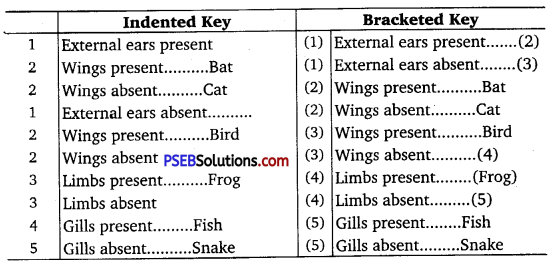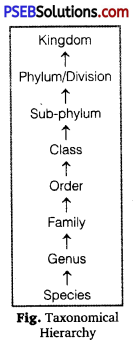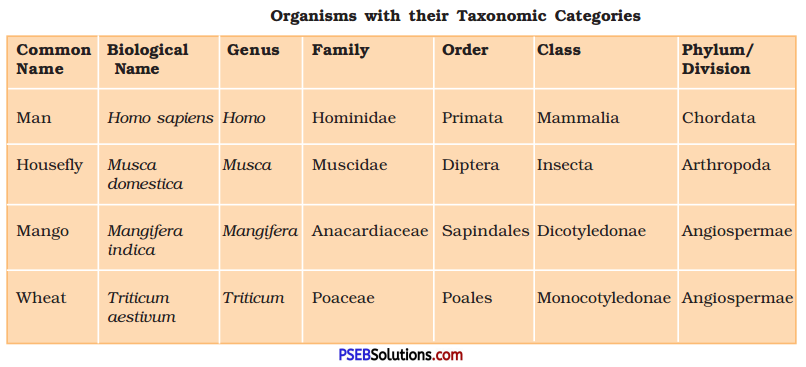Punjab State Board PSEB 11th Class Biology Book Solutions Chapter 1 The Living World Textbook Exercise Questions and Answers.
PSEB Solutions for Class 11 Biology Chapter 1 The Living World
PSEB 11th Class Biology Guide The Living World Textbook Questions and Answers
Question 1.
Why are living organisms classified?
Answer:
Living organisms are classified because:
- there are millions of organisms on the earth, which need a proper system of classification for identification.
- a number of new organisms are discovered each year. They require a particular system to be identified and to find out their correct position in a group.
Question 2.
Why are the classification systems changing every now and then?
Answer:
Evolution is the major factor responsible for the change in classification systems. Since, evolution still continues, so many different species of plants and animals are added in the already existed biodiversity. These newly discovered plant and animal specimens are then identified, classified and named according to the already existing classification systems. Due to evolution, animal and plant species keep on changing, so necessary changes in the already existed classification systems are necessary to place every newly discovered plant and animal in their respective ranks.
![]()
Question 3.
What different criteria would you choose to classify people that you meet often?
Answer:
The different scientific criteria to classify people that we meet often would be :
(i) Nomenclature: It is the science of providing distinct and proper names to the organisms. It is the determination of correct name as per established universal practices and rules.
(ii) Classification: It is the arrangement of organisms into categories based on systematic planning. In classification various categories used are class, order, family, genus and species.
(iii) Identification: It is the determination of correct name and place of an organism. Identification is used to tell that a particular species is similar to other organism of known identity. This includes assigning an organism to a particular taxonomic group.
The same criteria can be applied to the people we meet daily. We can identify them will their names classify them according to their living areas, profession, etc.
Question 4.
What do we learn from identification of individuals and populations?
Answer:
Identification of individuals and population categorized it into a species. Each species has unique characteristic features. On the basis of these features, it can be distinguished from other closely related species, e. g.,

Question 5.
Given below is the scientific name of Mango. Identify the correctly written name.
(i) Mangifera Indica
(ii) Mangifera indica.
Answer:
(ii) Mangifera indica (the name of species can never begins with a capital letter).
![]()
Question 6.
Define a taxon. Give some examples of taxa at different hierarchical levels.
Answer:
Taxon is a grouping of organisms of any level in hierarchical classification, which is based on some common characteristics, e.g., insects represent a class of phylum – Arthropoda. All the insects possess common characters of three pairs of jointed legs. The term ‘taxon’ was introduced by ICBN in 1956. Examples of taxa are kingdom, phylum or division, class, order, family, genus and species. These taxa form taxonomic hierarchy, e.g., taxa for human :
Phylum – Chordata
Class – Mammalia
Order – Primata
Family – Hominidae
Genus – Homo
Species – sapiens
Question 7.
Can you identify the correct sequence of taxonomical categories?
(a) Species → Order → Phylum → Kingdom
(b) Genus → Species → Order → Kingdom
(c) Species → Genus → Order → Phylum
Answer:
The correct sequence of taxonomical categories is as follows :
Species → Genus → Order → Phylum
Question 8.
Try to collect all the currently accepted meanings for the word ‘species’. Discuss with your teacher the meanings of species in case of higher plants and animals on one hand, and bacteria on the other hand.
Answer:
A group of individual organisms with fundamental similarities is called species. It can be distinguished from other closely related species on the basis of distinct morphological differences.
In case of higher plants and animals, one genus may have one or more than one species, e.g.,Panthera leo (lion) and Panthera tigris (tiger).
In this example, Panthera is genus, which includes leo (lion) and tigris (tiger) as species.
In case of bacteria, different categories are present on the basis of shape. These are spherical, coccus, rod-shaped, comma and spiral-shaped. Thus, meaning of species in case of higher organisms and bacteria are different.
![]()
Question 9.
Define and understand the following terms:
(i) Phylum,
(ii) Class,
(iii) Family,
(iv) Order,
(v) Genus.
Answer:
(i) Phylum: Phylum comes next to Kingdom in the taxonomical hierarchy. All broad characteristics of an animal or plant are defined in a phylum. For example all chordates have a notochord and gill at some stage of life cycle. Similarly all arthropods have jointed legs made of chitin.
(ii) Class: The category class includes related orders. It is higher than order and lower than phylum. For example, class – Mammalia has order – Carnivora, Primata, etc.
(iii) Family: It is the category higher than genus and lower than order, which has one or more related genera having some common features. For example, Felidae, Canidae, etc.
(iv) Order: Order further zeroes down on characteristics and includes related genus. For example humans and monkeys belong to the order primates. Both humans and monkeys can use their hands to manipulate objects and can walk on their hind legs.
(v) Genus: It comprises a group of related species which has more characters in common in comparison to species of other genera. We can say that genera are aggregates of closely related species. For example, j potato, tomato and brinjal are three different species but all belong to the genus Solatium. Lion (Panthera leo), leopard (P. pardus) and tiger (P. tigris) with several common features, are all species of the genus Panthera. This genus differs from another genus Felis which includes cats.
Question 10.
How is a key helpful in the identification and classification of an
organism?
Answer:
Key is a device (scheme) of diagnostic alternate (contrasting) characters, which provide an easy means for the identification of unknown organism. The keys are taxonomic literature based on the contrasting characters generally a pair called couplet. Each statement in the key is called a lead. Separate taxonomic keys are required for each taxonomic category such as family, genus and species for identification purposes. Being analytical ‘ in nature, two types of keys are commonly used-indented key and bracketed key.
(i) Indented key provides sequence of choice between two or more statements of characters of species. The user has to make correct choise for identification.
(ii) Bracketed key (1) are used for contrasting characters like indented key but they are not repeated by intervening sub-dividing character and each character is given a number in brackets.

![]()
Question 11.
Illustrate the taxonomical hierarchy with suitable examples of a plant and an animal.
Answer:

Taxonomical hierarchy is the system of arrangement of taxonomic categories in a descending order depending upon their relative dimensions. It was introduced by Linnaeus (1751) and is therefore, also called Linnaeus hierarchy. Each category, referred to as a unit of classification commonly called as taxon (pi. taxa), e.g., taxonomic categories and hierarchy can be illustrated by a group of organisms, i.e., insects. The common features of insects is ‘three pair of jointed legs’. It means insects are recognisable objects which can be classified, so given a rank or category.
Category further denotes a rank. Each rank or taxon, represents a unit of classification taxonomic studies of all plants and animals led to the development of common categories such as kingdom, phylum or division (for plants), class, order, family, genus and species. All organisms, including those in the plant and animal, kingdoms have ‘species’ as the lowest category.
To place an organism in various categories is to have the knowledge of characters of an individual or group of organism. This helps to identify similarities and dissimilarities among the individual of the same kind of organisms as well as of other kinds of organism. Some organisms with their taxonomical categories are given in following table:

